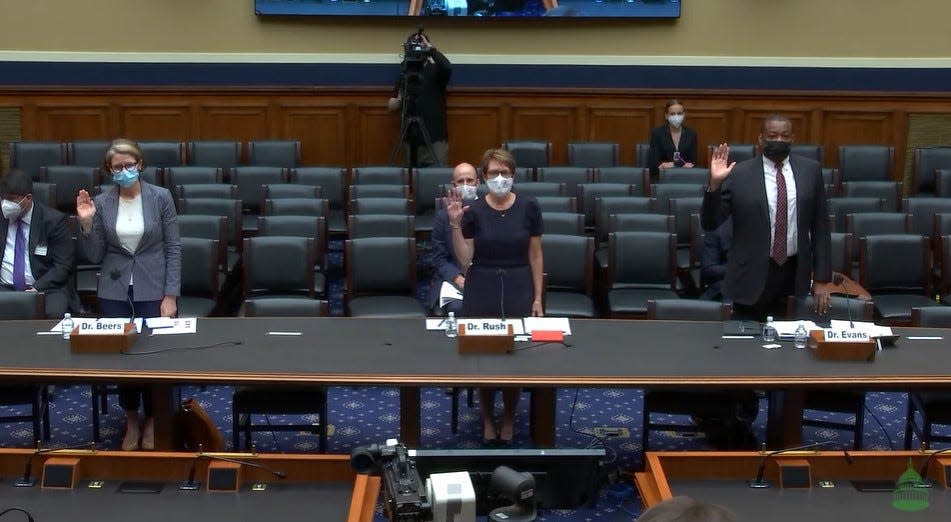How the American Academy of Pediatrics' guidelines became the standard for kids + COVID
Throughout the pandemic, the job of calming jittery families and promoting kid safety has fallen to America's pediatricians. Behind them all is a staid professional organization that's now a household name: the American Academy of Pediatrics, a 91-year-old group that represents the country's 67,000 child doctors.
For nearly two years, the academy's data on COVID-19 and kids and guidance for parents has been fast and user-friendly. The group took early stances rooted in science, such as recommending an earlier return to school with just 3 feet of distancing, which contradicted government guidance at the time.
With children ages 5 to 11 soon to be eligible for the vaccine, Lee Savio Beers, the academy's president this year, spoke with USA TODAY about the organization's work, how to stay safe in school and why it's important to vaccinate younger children.
Did America’s schools open safely? We crunched the latest data on COVID and kids.
Kid vaccines are coming: Don’t miss an update with the Coronavirus Watch newsletter.
Beers spoke from her home in Washington, D.C., which she shares with her husband, a fellow pediatrician, and two teenagers.

This Q&A has been edited slightly for length and clarity.
The American Academy of Pediatrics became a household name during the pandemic — its data on child infections, hospitalizations and deaths were quickly posted and widely quoted. What was happening behind the scenes that made that possible?
People were looking at the big picture, but nobody was looking specifically at how COVID and the pandemic were affecting children.
We modeled what we did on disaster management. We pulled together an incident response team. We pulled together expert leaders: Many are pediatricians; some are data scientists. We have people with specialties in infectious disease, school health, disaster management, infection control.
Our data team partnered with staff at the Children's Hospital Association to pull together state-level data about kids and COVID and collate that into one place. It's the most comprehensive data source there is, and yet we are still limited by how states report their data and whether they break it out by ages.
How did you develop recommendations, such as for 3 feet of distance being sufficient for kids to return to school? The Centers for Disease Control and Prevention initially recommended 6 feet of distance, then later revised that to match your guidance.
We have a policy development process for best practices in child health, but that takes years. That was not the right structure here, so we developed a process for interim guidance around pandemic-related topics. Our experts looked at the literature, and what was reported but not necessarily in literature.
Their recommendations for interim guidance come through our senior pediatrician staff, then to the executive committee, then to the full board for review.
We review all of our topics for interim guidance every 30 days to assess if there's new information we need to take under consideration.
We also work carefully with our government partners. The vast majority of the time we’ve been aligned. In times when we weren’t, people took it more seriously because of our expertise. Rather than pushback, there was an, "Oh, ok, let’s dive deeper into that and see why they’re making that recommendation."

What have pediatricians been surprised by most during the pandemic?
Certainly we all hoped we'd be on the other side of this by now. What surprised us is the extent to which the divisiveness around public health measures has influenced the pandemic response and the ways families were thinking and feeling. Pediatricians are there because they want to take the best possible care of kids and families they serve. When societal divisiveness starts to interfere with that, it makes it hard.
Is there any major disagreement among pediatricians about the importance of virus mitigation measures like vaccinations and masks?
We hear over and over from our members that they support our recommendations around masking and vaccinations.
Some parents still believe COVID-19 isn’t that big of a deal for children. In a normal year, more children die of the flu. How do you respond to that?
Children generally are very healthy. Looking at some recent analyses of the COVID death rate in kids, for the year, it was the eighth-highest cause of death. And for the past couple months, the sixth-highest cause of death. That’s not insignificant.
Pediatrics is really about prevention. If we have safe and effective ways to prevent serious illness or death in a child, that’s an important thing to know and to do. If you’re the parent of a child who becomes very ill or dies, the statistics don’t matter to you. What matters is that your child has suffered because of preventable illness.
How safe are the COVID-19 vaccines for children?
They’re very safe and effective.
What are the cases in which a pediatrician might not recommend vaccinating a child?
Maybe if the child has a history of severe allergic reactions to components of the vaccine, but that’s extraordinarily rare. Other circumstances that are specialized, such as heart conditions, might require a conversation between the doctor and the family.
Why should we vaccinate healthy children?
COVID-19 can cause serious illness in children, and that risk far exceeds the risk of the vaccine. And, the more people who are vaccinated, the less likely the virus is to spread into potentially new variants. Lastly, kids being vaccinated will make it easier for them to stay in school and not worry about quarantine.
What about if a child has already had COVID-19?
We recommend the vaccine even if your child has already had COVID. The immunity you get from natural infection is variable. For some, it's strong and long-lasting. For others, it dissipates quickly. There's no way to know what category you fall into. And we’ve seen people get COVID more than once.
Do you think most children ages 5 to 11 will get their COVID shots through their pediatrician's office? Nationally, 70% of COVID-19 vaccinations have been given by pharmacists.
I think it will be both. But the younger a child is, the more likely the family is to get their vaccine at the pediatrician's office.
Did returning to in-person school this year go better or worse than you expected?
It really varied. Places that were careful and put in mitigation measures were largely able to return safely, and that was consistent with what we thought would happen. And schools that didn’t do those things, it was rough.

When will the academy drop its recommendation for universal masking in schools?
We review our interim guidance every 30 days, but it has to do with the level of COVID spread in communities and vaccination rates. The infection numbers are coming down, but they’re still at some of the highest rates we’ve seen. Only about half of teens nationwide who are eligible are vaccinated. As of today, 5- to 11-year-olds are not yet eligible and we hope that changes soon.
Vaccine hesitant: Only 27% of parents eager to have kids ages 5-11 vaccinated
What data do you wish governments were collecting that could help better determine the safest path for navigating school and family life?
Having consistent guidance across states for the collection and reporting of cases of COVID in kids. Also, it would be super helpful to have schools consistently reporting how many cases they have.
The academy recently called child mental health a “national emergency.” Why?
Rates of children's mental health concerns have been increasing dramatically over the past five to 10 years, and we were concerned about that prior to the pandemic. As more kids are getting back to in-person learning, we’re not seeing the recovery that we hoped for, and we’re not seeing the investment to take care of the kids. Pediatricians are overwhelmed with kids and families with mental health concerns.

What should schools and communities be doing to address it?
We need an investment of resources to increase access to mental health services. Our mental health colleagues are chronically underfunded.
We need different types of training opportunities for staff who are already in schools to support kids in their social and emotional development. We need to develop suicide-prevention screening, and new ways for staff to provide extra support. We're also seeing kids with more intensive needs and they’re struggling to get beds in hospitals or day services.
Remember, kids thrive with safe, stable, loving adult relationships. If every adult thought, how can I help with this in my community? – we'd be in a better place. Can I volunteer? Coach a team? Donate books to a school?
Anything else?
I'd like to remind families to make sure you’re up to date on all your other vaccinations. Lots of kids have fallen behind. You need to get your flu shot. And think about the equity of vaccine distribution. We need to make sure the vaccine is easily accessible to everybody.
Fast facts
Lee Savio Beers, pediatrician
Age: 50
Job: Practices at Children's National Hospital, in Washington, D.C. She's on leave from clinical work for a year to serve as president of the American Academy of Pediatrics.
Hometown: Arnold, Maryland
Education: Medical school at Emory University in Atlanta
Family: Husband, daughter (16), son (13)
Pets: Dog (Carli), cat (Luna)
Contact Erin Richards at (414) 207-3145 or erin.richards@usatoday.com. Follow her on Twitter at @emrichards.
This article originally appeared on USA TODAY: AAP guidelines: Pediatricians on kid COVID vaccines, school, masks

 Yahoo Movies
Yahoo Movies 
